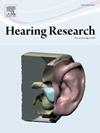Distortion-product otoacoustic emission input-output characteristics of misophonic ears with normal hearing
IF 2.5
2区 医学
Q1 AUDIOLOGY & SPEECH-LANGUAGE PATHOLOGY
引用次数: 0
Abstract
Purpose
The study aimed to evaluate the cochlear non-linear mechanisms in individuals with misophonia. We compared the absolute amplitude of distortion product otoacoustic emission (DPOAE) as a function of input using distortion product otoacoustic emissions input-output (DPOAE I/O) test and the slope of input-output curve in individuals with and without misophonia.
Methods
Total of 60 participants with normal hearing were split into two groups - with misophonia (30 participants, 60 ears) and without misophonia (30 participants, 60 ears), were considered in the study. The misophonic group was further divided into mild (16 participants, 32 ears) and moderate/severe (14 participants, 28 ears) misophonia groups based on the misophonia severity, which was assessed using the misophonia assessment questionnaire (MAQ). DPOAE amplitudes (output) corresponding to input levels of 45 to 75 dB SPL (5 dB steps) were obtained bilaterally for all the participants for six frequencies: 1 kHz, 1.5 kHz, 2 kHz, 3 kHz, 4 kHz, and 6 kHz. Along with amplitude (DPOAE O/P), the DPOAE I/O slope for each of the six frequencies was calculated.
Results
The results of Kruskal Wallis H-test comparing DPOAE amplitudes at different input intensities between the three groups showed a statistically significant difference (p < 0.01) at 2 kHz at all input intensities. Post hoc analysis showed Statistically significant differences (p < 0.05) between (i) non-misophonics and moderate/severe misophonics at all input levels, and (ii) between mild misophonics and moderate/severe misophonics at input levels of 60, 65, 70, and 75 dB SPL. Statistically significant difference was also observed at 1 kHz for input levels of 50, 60, and 75 dB SPL, while post hoc analysis showed no significant differences between the three groups. Individuals with moderate/severe misophonia showed reduced DPOAE amplitudes at all input intensities. Although not statistically significant, the DPOAE I/O mean amplitudes at 1 kHz and 1.5 kHz were lower in individuals with moderate/severe misophonia when compared to individuals without misophonia. The Kruskal Wallis H-test showed no statistically significant difference (p > 0.05) in input-output slope between individuals with (mild or moderate/severe) misophonia and without misophonia.
Conclusion
The results suggest subtle differences in cochlear non-linear mechanisms in individuals with misophonia. These alterations represented at the higher auditory centres may indicate a possible contribution towards misophonia development.
正常听力的恐音耳的畸变积耳声发射输入输出特性。
目的:探讨恐音症患者耳蜗非线性机制。我们采用失真积耳声发射输入输出(DPOAE)测试,比较了有恐音症和无恐音症个体的失真积耳声发射(DPOAE)作为输入函数的绝对振幅和输入输出曲线的斜率。方法:将60名听力正常的受试者分为有恐音症(30人,60耳)和无恐音症(30人,60耳)两组。根据恐音症的严重程度,将恐音症组分为轻度(16人,32耳)和中度/重度(14人,28耳)两组,采用恐音症评估问卷(MAQ)进行评估。在6个频率:1 kHz、1.5 kHz、2 kHz、3 kHz、4 kHz和6 kHz下,所有参与者的双侧DPOAE振幅(输出)对应于45至75 dB SPL (5 dB步进)的输入电平。与振幅(DPOAE O/P)一起,计算6个频率的DPOAE I/O斜率。结果:Kruskal Wallis h检验比较三组在不同输入强度下的DPOAE振幅结果显示,在2 kHz各输入强度下,三组DPOAE振幅差异有统计学意义(p < 0.01)。后分析显示(i)在所有输入水平下,无音错音与中度/重度音错音之间存在统计学差异(p < 0.05); (ii)在60、65、70和75 dB SPL输入水平下,轻度音错音与中度/重度音错音之间存在统计学差异。在1 kHz时,50、60和75 dB声压级的输入水平也观察到统计学上的显著差异,而事后分析显示三组之间没有显著差异。中度/重度恐音症患者在所有输入强度下的DPOAE振幅均降低。中度/重度恐音症患者1 kHz和1.5 kHz的DPOAE I/O平均振幅低于无恐音症患者,但差异无统计学意义。Kruskal - Wallis h检验显示(轻度、中度/重度)恐音症患者与非恐音症患者的投入-产出斜率差异无统计学意义(p > 0.05)。结论:恐音症患者耳蜗非线性机制存在细微差异。这些发生在高级听觉中枢的改变可能是恐音症发展的原因之一。
本文章由计算机程序翻译,如有差异,请以英文原文为准。
求助全文
约1分钟内获得全文
求助全文
来源期刊

Hearing Research
医学-耳鼻喉科学
CiteScore
5.30
自引率
14.30%
发文量
163
审稿时长
75 days
期刊介绍:
The aim of the journal is to provide a forum for papers concerned with basic peripheral and central auditory mechanisms. Emphasis is on experimental and clinical studies, but theoretical and methodological papers will also be considered. The journal publishes original research papers, review and mini- review articles, rapid communications, method/protocol and perspective articles.
Papers submitted should deal with auditory anatomy, physiology, psychophysics, imaging, modeling and behavioural studies in animals and humans, as well as hearing aids and cochlear implants. Papers dealing with the vestibular system are also considered for publication. Papers on comparative aspects of hearing and on effects of drugs and environmental contaminants on hearing function will also be considered. Clinical papers will be accepted when they contribute to the understanding of normal and pathological hearing functions.
 求助内容:
求助内容: 应助结果提醒方式:
应助结果提醒方式:


